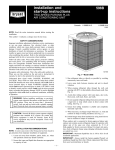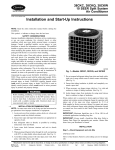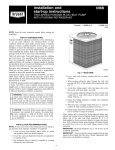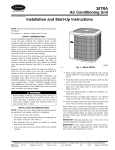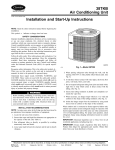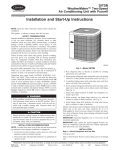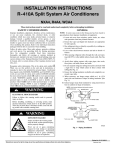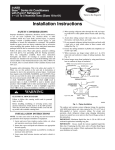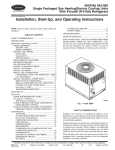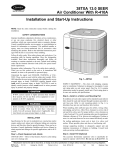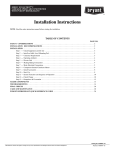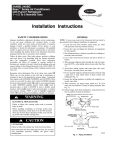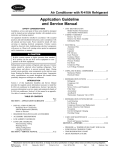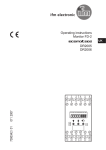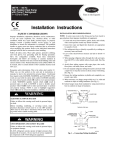Download installation and start-up instructions
Transcript
installation and start-up instructions 12, 13, 14 SEER SPLIT-SYSTEM AIR CONDITIONERS WITH PURON™ (R-410A) REFRIGERANT Cancels: II 550A-24-2 552A 550A 556A II 550A-24-3 1-98 NOTE: Read the entire instruction manual before starting the installation. This symbol → indicates a change since the last issue. SAFETY CONSIDERATIONS Improper installation, adjustment, alteration, service, maintenance, or use can cause explosion, fire, electrical shock, or other conditions which may cause death, personal injury, or property damage. Consult a qualified installer, service agency, or your distributor or branch for information or assistance. The qualified installer or agency must use factory-authorized kits or accessories when modifying this product. Refer to the individual instructions packaged with the kits or accessories when installing. Follow all safety codes. Wear safety glasses, protective clothing, and work gloves. Use quenching cloth for brazing operations. Have fire extinguisher available. Read these instructions thoroughly and follow all warnings or cautions included in literature and attached to the unit. Consult local building codes and National Electrical Code (NEC) for special requirements. . Recognize safety information. This is the safety-alert symbol When you see this symbol on the unit and in instructions or manuals, be alert to the potential for personal injury. Understand the signal words DANGER, WARNING, and CAUTION. These words are used with the safety-alert symbol. DANGER identifies the most serious hazards which will result in severe personal injury or death. WARNING signifies hazards which could result in personal injury or death. CAUTION is used to identify unsafe practices which would result in minor personal injury or product and property damage. A97272 Fig. 1 4. Leave some slack between structure and unit to absorb vibration. 5. When passing refrigerant tubes through the wall, seal opening with RTV or other pliable silicon-based caulk. (See Fig. 2.) 6. Avoid direct tubing contact with water pipes, duct work, floor joists, wall studs, floors, and walls. 7. Do not suspend refrigerant tubing from joists and studs with a rigid wire or strap which comes in direct contact with tubing. (See Fig. 2.) 8. Ensure that tubing insulation is pliable and completely surrounds vapor tube. 9. When necessary, use hanger straps which are 1 in. wide and conform to shape of tubing insulation. (See Fig. 2.) 10. Isolate hanger straps from insulation by using metal sleeves bent to conform to shape of insulation. When outdoor unit is connected to factory-approved indoor unit, outdoor unit contains system refrigerant charge for operation with ARI rated indoor unit with highest sales volume when connected by 15 ft of field-supplied or factory accessory tubing. For proper unit operation, check refrigerant charge using charging information located on control box cover. IMPORTANT: Maximum liquid-line size is 3/8-in. O.D. for all residential applications including long line. IMPORTANT: Always install the factory-supplied liquid-line filter drier. If replacing the filter drier, refer to Product Data Sheet for appropriate part number. Obtain replacement filter driers from or your distributor or branch. WARNING: Before installing, modifying, or servicing system, main electrical disconnect switch must be in the OFF position. There may be more than 1 disconnect switch. Lock out and tag switch with a suitable warning label. Electrical shock can cause personal injury or death. CAUTION: Puron™ (R-410A) systems operate at higher pressures than standard R-22 systems. Do not use R-22 service equipment or components on Puron™ (R-410A) equipment. INSTALLATION RECOMMENDATIONS NOTE: In some cases noise in the living area has been traced to gas pulsations from improper installation of equipment. 1. Locate unit away from windows, patios, decks, etc. where unit operation sound may disturb customer. 2. Ensure that vapor and liquid tube diameters are appropriate to capacity of unit. 3. Run refrigerant tubes as directly as possible by avoiding unnecessary turns and bends. —1— NOTE: Avoid contact between tubing and structure OUTDOOR WALL INDOOR WALL CAULK LIQUID TUBE CL A B VAPOR TUBE INSULATION THROUGH THE WALL JOIST HANGER STRAP (AROUND VAPOR TUBE ONLY) 3⁄8 IN. INSULATION VAPOR TUBE DIA TIEDOWN KNOCKOUTS (2) PLACES IN BASEPAN 8 3⁄16″ DIMENSIONS (IN.) A97375 MINIMUM TIEDOWN KNOCKOUT LOCATIONS MOUNTING PAD A B DIMENSIONS 024–060 26 X 32 5-1/16 9-11/16 UNIT SIZE Fig. 3—Mounting Unit to Pad 1″ MIN. LIQUID TUBE III. CLEARANCE REQUIREMENTS When installing, allow sufficient space for airflow clearance, wiring, refrigerant piping, and service. Allow 30-in. clearance to service end of unit and 48 in. above unit. For proper airflow, a 6-in. clearance on 1 side of unit and 12 in. on all remaining sides must be maintained. Maintain a distance of 24 in. between units. Position so water, snow, or ice from roof or eaves cannot fall directly on unit. On rooftop applications, locate unit at least 6 in. above roof surface. IV. OPERATING AMBIENTS The minimum outdoor operating ambient in cooling mode is 55°F, and the maximum outdoor operating ambient in cooling mode is 125°F. → V. CHECK INDOOR CHECK-FLO-RATER® PISTON AND INSTALL PISTON RING (552A/550A STANDARD) If unit is to be installed with a piston metering device, proceed as follows: 1. Check indoor coil piston to see if it matches the required piston shown on outdoor unit rating plate. If it does not match, replace indoor coil piston with piston shipped with outdoor unit. The piston shipped with outdoor unit is correct for any approved indoor coil combination. 2. After correct piston is installed, locate neoprene piston ring shipped in piston bag. Install piston ring behind metering piston as shown in Fig. 4. The piston ring ensures that piston stays seated during all operating conditions. VI. INSTALL TXV (556A STANDARD; 552A/550A OPITONAL) NOTE: ALL 556A UNITS MUST BE INSTALLED WITH A TXV—NO EXCEPTIONS! The thermostatic expansion valve is specifically designed to operate with Puron™ (R-410A). Do not use an R-22 TXV. An existing R-22 TXV must be replaced with a factory-approved TXV specifically designed for Puron™ (R-410A). To replace an R-22 TXV, refer to Installation Instructions packaged with accessory kit. → NOTE: FK4 and FC4 fan coils are equipped with an R-22 TXV. If an FK4 or an FC4 fan coil is used with an Puron™ (R-410A) air conditioner, the R-22 TXV must be replaced with an Puron™ (R-410A) TXV or with the accessory piston body kit and piston shipped with outdoor unit. SUSPENSION A94028 Fig. 2—Connecting Tubing Installation INSTALLATION Specifications for this unit in residential new construction market require the outdoor unit, indoor unit, refrigerant tubing sets, metering device, and filter drier listed in presale literature. There can be no deviation. Consult the Application Guideline and Service Manual—Air Conditioner with Puron™ (R-410A) Refrigerant to obtain required unit changes for specific applications and for R-22 retrofit. I. CHECK EQUIPMENT AND JOB SITE A. Unpack Unit Move to final location. Remove carton taking care not to damage unit. B. Inspect Equipment File claim with shipping company prior to installation if shipment is damaged or incomplete. Locate unit rating plate on unit corner panel. It contains information needed to properly install unit. Check rating plate to be sure unit matches job specifications. II. INSTALL ON A SOLID, LEVEL MOUNTING PAD If conditions or local codes require the unit be attached to pad, tie down bolts should be used and fastened through knockouts provided in unit base pan. Refer to unit mounting pattern in Fig. 3 to determine base pan size and knockout hole location. On rooftop applications, mount on level platform or frame. Place unit above a load-bearing wall and isolate unit and tubing set from structure. Arrange supporting members to adequately support unit and minimize transmission of vibration to building. Consult local codes governing rooftop applications. Roof mounted units exposed to winds above 5 mph may require wind baffles. Consult the Application Guideline and Service Manual—Air Conditioner with Puron™ (R-410A) Refrigerant for wind baffle construction. NOTE: Unit must be level to within ± 2° (± 3/8 in./ft) per compressor manufacturer specifications. —2— Outdoor units may be connected to indoor section using accessory tubing package or field-supplied refrigerant grade tubing of correct size and condition. For tubing requirements beyond 50 ft, substantial capacity and performance losses can occur. Following the recommendations in the Application Guideline and Service Manual—Air Conditioner with Puron™ (R-410A) Refrigerant will reduce these losses. Refer to Table 1 for field tubing equivalent line length. Refer to Table 2 for accessory requirements. For buried-line applications greater than 36 in., refer to Table 2 and Residential Split System Buried-Line Application Guideline. Buried line applications may not exceed 100 ft. If refrigerant tubes or indoor coil are exposed to atmosphere, they must be evacuated to 500 microns to eliminate contamination and moisture in the system. A. Outdoor Unit Connected to Factory-Approved Indoor Unit CAUTION: Remove indoor coil piston if unit is to be installed on system with a TXV metering device. PISTON RETAINER PISTON RING PISTON PISTON BODY Outdoor unit contains correct system refrigerant charge for operation with ARI rated indoor unit with highest sales volume when connected by 15 ft of field-supplied or factory-accessory tubing. Check refrigerant charge for maximum efficiency. B. Install Liquid-Line Filter Drier FIELD CONNECTION STRAINER CAUTION: Installation of filter drier in liquid line is required. FLARE ADAPTOR Refer to Fig. 5 and install filter drier as follows: 1. Braze 5-in. connector tube to liquid service valve. Wrap filter drier with damp cloth. 2. Braze filter drier between connector tube and liquid tube to indoor coil. Flow arrow must point towards indoor coil. LIQUID LINE STRAINER APPROX. 2” LONG STRAINER LABEL (AFFIX TO LIQ. LINE NEAR STRAINER LOCATION) LIQUID-LINE FILTER-DRIER A95615 LIQUID SERVICE VALVE Fig. 4—Check-Flo-Rater Components VII. MAKE PIPING CONNECTIONS WARNING: Relieve pressure and recover all refrigerant before system repair or final unit disposal to avoid personal injury or death. Use all service ports and open all flow-control devices, including solenoid valves. R- 4 1 0A CONNECTOR TUBE CAUTION: Do not leave system open to atmosphere any longer than minimum required for installation. POE oil in compressor is extremely susceptible to moisture absorption. Always keep ends of tubing sealed during installation. A95509 Fig. 5—Liquid-Line Filter Drier C. Refrigerant Tubing Connect vapor tube to fitting on outdoor unit vapor service valves. Connect liquid tube to filter drier. (See Fig. 5 and Table 1.) Use refrigerant grade tubing. D. Sweat Connection CAUTION: If ANY refrigerant tubing is buried, provide a 6 in. vertical rise at service valve. Refrigerant tubing lengths up to 36 in. may be buried without further special consideration. For lengths above 36 in., refer to the Residential Split System Buried-Line Application Guideline. CAUTION: To avoid valve damage while brazing, service valves must be wrapped in a heat-sinking material such as a wet cloth. CAUTION: To prevent damage to unit or service valves observe the following: • Use a brazing shield. • Wrap service valves with wet cloth or use a heat sink material. Service valves are closed from factory and ready for brazing. After wrapping service valve and filter drier with a wet cloth, tubing set can be brazed to service valve and filter drier using either silver bearing or non-silver bearing brazing material. Consult local code requirements. Refrigerant tubing and indoor coil are now ready for leak testing. This check should include all field and factory joints. —3— → TABLE 1—REFRIGERANT CONNECTIONS AND RECOMMENDED LIQUID AND VAPOR TUBE DIAMETERS (IN.) UNIT SIZE 024 030, 036 042, 048 060 LIQUID Connection Diameter Tube Diameter 3/8 3/8 3/8 3/8 3/8 3/8 3/8 3/8 VAPOR Connection Diameter Tube Diameter 5/8 5/8 3/4 3/4 7/8 7/8 7/8 1-1/8 VAPOR (LONG LINE) Connection Diameter Tube Diameter 5/8 3/4 3/4 7/8 7/8 1-1/8 7/8 1-1/8 NOTES: 1. Tube diameters are for lengths up to 50 ft. For tubing lengths greater than 50 ft, consult Application Guideline and Service Manual—Air Conditioner with Puron™ (R-410A). 2. Do not apply capillary tube indoor coils to these units. E. Evacuate Refrigerant Tubing and Indoor Coil MICRONS CAUTION: Never use the system compressor as a vacuum pump. Refrigerant tubes and indoor coil should be evacuated using the recommended deep vacuum method of 500 microns. The alternate triple evacuation method may be used if the procedure outlined below is followed. Always break a vacuum with dry nitrogen. DEEP VACUUM METHOD The deep vacuum method requires a vacuum pump capable of pulling a vacuum of 500 microns and a vacuum gage capable of accurately measuring this vacuum depth. The deep vacuum method is the most positive way of assuring a system is fee of air and liquid water. (See Fig. 6.) 5000 4500 4000 3500 3000 2500 2000 1500 1000 500 LEAK IN SYSTEM VACUUM TIGHT TOO WET TIGHT DRY SYSTEM 0 1 2 3 4 MINUTES 5 6 7 A95424 TRIPLE EVACUATION METHOD The triple evacuation method should only be used when vacuum pump is only capable of pumping down to 28 in. of mercury vacuum and system does not contain any liquid water. Refer to Fig. 7 and proceed is as follows: Fig. 6—Deep Vacuum Graph 5. Repeat this procedure as indicated in Fig. 7. System will then be free of any contaminants and water vapor. VIII. MAKE ELECTRICAL CONNECTIONS WARNING: To avoid personal injury or death, do not supply power to unit with compressor terminal box cover removed. 1. Pump system down to 28 in. of mercury and allow pump to continue operating for an additional 15 minutes. 2. Close service valves and shut off vacuum pump. 3. Connect a dry nitrogen cylinder and regulator to system and open until system pressure is 2 psig. Be sure field wiring complies with local and national fire, safety, and electrical codes, and voltage to system is within limits shown on unit rating plate. Contact local power company for correction of improper voltage. See unit rating plate for recommended circuit protection device. 4. Close service valve and allow system to stand for 1 hr. During this time, dry nitrogen will be able to diffuse throughout the system absorbing moisture. → TABLE 2—ACCESSORY USAGE ACCESSORY Crankcase Heater Evaporator Freeze Thermostat Winter Start Control Accumulator Compressor Start Assist Capacitor and Relay Low-Ambient Controller, MotorMaster® Control, or Low-Ambient Pressure Switch Wind Baffle Coastal Filter Support Feet Liquid-Line Solenoid Valve or Hard Shutoff TXV Ball Bearing Fan Motor REQUIRED FOR LOW-AMBIENT APPLICATIONS (BELOW 55°F) Yes Yes Yes‡ No REQUIRED FOR LONG-LINE APPLICATIONS* (OVER 50 FT) Yes No No No REQUIRED FOR BURIED LINE APPLICATIONS† (OVER 3 FT) Yes No No Yes REQUIRED FOR SEA COAST APPLICATIONS (WITHIN 2 MILES) No No No No Yes Yes Yes No Yes No No No See Low-Ambient Instructions No Recommended No No No See Long-Line Application Guideline No No No No No Yes Recommended Yes No No No No Yes** * For tubing line sets between 50 and 175 ft, refer to Application Guideline and Service Manual—Air Conditioner with Puron™ (R-410A). † For buried line applications, refer to Residential Split System Buried-Line Application Guideline. ‡ Only when low-pressure switch is used. ** Required for Low-Ambient Controller (full modulation feature) and MotorMaster Control only. —4— DISCONNECT PER N. E. C. AND/OR LOCAL CODES EVACUATE CONTACTOR BREAK VACUUM WITH DRY NITROGEN FIELD POWER WIRING WAIT EVACUATE FIELD GROUND WIRING BREAK VACUUM WITH DRY NITROGEN GROUND LUG A91056 WAIT Fig. 8—Line Power Connections IX. EVACUATE COMPRESSOR CRANKCASE HEATER When equipped with a crankcase heater, furnish power to heater a minimum of 24 hr before starting unit. To furnish power to heater only, set thermostat to OFF and close electrical disconnect to outdoor unit. A crankcase heater is required if refrigerant tubing is longer than 50 ft. Refer to Application Guideline and Service Manual—Air Conditioner with Puron™ (R-410A). CHECK FOR TIGHT, DRY SYSTEM (IF IT HOLDS DEEP VACUUM) CHARGE SYSTEM A95425 Fig. 7—Triple Evacuation Method NOTE: Operation of unit on improper line voltage constitutes abuse and could affect unit reliability. See unit rating plate. Do not install unit in system where voltage may fluctuate above or below permissible limits. NOTE: Use copper wire only between disconnect switch and unit. NOTE: Install branch circuit disconnect of adequate size per NEC to handle unit starting current. Locate disconnect within sight from and readily accessible from unit, per Section 440-14 of NEC. X. INSTALL ELECTRICAL ACCESSORIES Refer to the individual instructions packaged with kits or accessories when installing. XI. START-UP CAUTION: To prevent compressor damage or personal injury, observe the following: • Do not overcharge system with refrigerant. • Do not operate unit in a vacuum or at negative pressure. • Do not disable low-pressure switch In scroll compressor applications: • Dome temperatures may be hot. • In 3 phase application, incorrect phasing will cause reverse rotation, resulting in elevated noise levels, equalized pressures, and reduced current draw. Correct by reversing power connection L1 and L2 on contactor. A. Route Ground and Power Wires Remove access panel to gain access to unit wiring. Extend wires from disconnect through power wiring hole provided and into unit control box. WARNING: The unit cabinet must have an uninterrupted or unbroken ground to minimize personal injury if an electrical fault should occur. The ground may consist of electrical wire or metal conduit when installed in accordance with existing electrical codes. Failure to follow this warning can result in an electric shock, fire, or death. CAUTION: To prevent personal injury wear safety glasses, protective clothing, and gloves when handling refrigerant and observe the following: • Back seating service valves are not equipped with Schrader valves. Fully back seat (counter clockwise) valve stem before removing gage port cap. • Front seating service valves are equipped with Schrader valves. B. Connect Ground and Power Wires Connect ground wire to ground connection in control box for safety. Connect power wiring to contactor as shown in Fig. 8. C. Connect Control Wiring Route 24-v control wires through control wiring grommet and connect leads to control wiring. (See Fig. 9.) Use No. 18 AWG color-coded, insulated (35°C minimum) wire. If thermostat is located more than 100 ft from unit, as measured along the control voltage wires, use No. 16 AWG color-coded wire to avoid excessive voltage drop. All wiring must be NEC Class 1 and must be separated from incoming power leads. Use furnace transformer, fan coil transformer, or accessory transformer for control power, 24-v/40-va minimum. NOTE: Use of available 24-v accessories may exceed the minimum 40-va power requirement. Determine total transformer loading and increase the transformer capacity or split the load with an accessory transformer as required. CAUTION: Do not vent refrigerant to atmosphere. Recover during system repair or final unit disposal. Follow these steps to properly pump down a system and avoid negative suction pressure. 1. After system is evacuated, fully back seat (open) liquid and vapor service valves. 2. Unit is shipped with valve stem(s) front seated (closed) and caps installed. Replace stem caps after system is opened to refrigerant flow (back seated). Replace caps finger-tight and tighten with wrench an additional 1/12 turn. 3. Close electrical disconnects to energize system. —5— TABLE 3—REQUIRED LIQUID-LINE TEMPERATURE (°F) 4. Set room thermostat at desired temperature. Be sure set point is below indoor ambient temperature. LIQUID PRESSURE AT SERVICE VALVE (PSIG) 5. Set room thermostat to COOL and fan control to ON or AUTO mode, as desired. Operate unit for 15 minutes. Check system refrigerant charge. A. 189 195 202 208 215 222 229 236 243 251 259 266 274 283 291 299 308 317 326 335 345 354 364 374 384 395 406 416 427 439 450 462 474 486 499 511 Sequence of Operation Turn on power to indoor and outdoor units. Transformer is energized. On a call for cooling, thermostat makes circuits R-Y and R-G. Circuit R-Y energizes contactor, starting outdoor fan motor and compressor circuit. R-G energizes indoor unit blower relay, starting indoor blower motor on high speed. When thermostat is satisfied, its contacts open, de-energizing contactor and blower relay. Compressor and motors stop. If indoor unit is equipped with a time-delay relay circuit, the indoor blower will run an additional 90 sec to increase system efficiency. XII. CHECK CHARGE A. Unit Charge Factory charge and charging method are shown on unit information plate. Puron™ (R-410A) refrigerant cylinders contain a dip tube which allows liquid refrigerant to flow from cylinder in upright position. Charge Puron™ (R-410A) units with cylinder in upright position and a commercial-type metering device in manifold hose. Charge refrigerant into suction line. NOTE: If superheat or subcooling charging conditions are not favorable, charge must be weighed in accordance with unit rating plate ± 0.5 oz/ft of 3/8-in. liquid line above or below 15 ft respectively. EXAMPLE: 25 ft - 15 ft = 10 ft X 0.5 oz/ft = 5 oz of additional charge B. Cooling Only Procedure Units with Cooling Mode TXV Units installed with cooling mode TXV require charging by the subcooling method. 1. Operate unit a minimum of 10 minutes before checking charge. 2. Measure liquid service valve pressure by attaching an accurate gage to service port. 3. Measure liquid line temperature by attaching an accurate thermistor type or electronic thermometer to liquid line near outdoor coil. 4. Refer to unit rating plate for required subcooling temperature. 5. Refer to Table 3. Find the point where required subcooling temperature intersects measured liquid service valve pressure. 6. To obtain required subcooling temperature at a specific liquid line pressure, add refrigerant if liquid line temperature is higher than indicated or reclaim refrigerant if temperature is lower. Allow a tolerance of ± 3°F. Units with Indoor Pistons Units installed with indoor pistons require charging by the superheat method. The following procedure is valid when indoor airflow is within ± 21% of its rated CFM. 1. Operate unit a minimum of 10 minutes before checking charge. 2. Measure suction pressure by attaching an accurate gage to suction valve service port. —6— 8 58 60 62 64 66 68 70 72 74 76 78 80 82 84 86 88 90 92 94 96 98 100 102 104 106 108 110 112 114 116 118 120 122 124 126 128 REQUIRED SUBCOOLING TEMPERATURE (°F) 10 12 14 16 56 54 52 50 58 56 54 52 60 58 56 54 62 60 58 56 64 62 60 58 66 64 62 60 68 66 64 62 70 68 66 64 72 70 68 66 74 72 70 68 76 74 72 70 78 76 74 72 80 78 76 74 82 80 78 76 84 82 80 78 86 84 82 80 88 86 84 82 90 88 86 84 92 90 88 86 94 92 90 88 96 94 92 90 98 96 94 92 100 98 96 94 102 100 98 96 104 102 100 98 106 104 102 100 108 106 104 102 110 108 106 104 112 110 108 106 114 112 110 108 116 114 112 110 118 116 114 112 120 118 116 114 122 120 118 116 124 122 120 118 126 124 122 120 18 48 50 52 54 56 58 60 62 64 66 68 70 72 74 76 78 80 82 84 86 88 90 92 94 96 98 100 102 104 106 108 110 112 114 116 118 TABLE 4—SUPERHEAT CHARGING OUTDOOR TEMP (°F) 55 60 65 70 75 80 85 90 95 100 105 110 115 EVAPORATOR ENTERING AIR TEMPERATURE (°F WB) 50 52 54 56 58 60 62 64 66 68 70 72 74 76 9 7 — — — — — — — — — — — 12 10 6 — — — — — — — — — — 14 12 10 7 — — — — — — — — — 17 15 13 10 6 — — — — — — — — 20 18 16 13 9 5 — — — — — — — 23 21 19 16 12 8 — — — — — — — 26 24 21 19 15 12 8 5 — — — — — 29 27 24 21 18 15 11 9 6 — — — — 32 30 27 24 21 18 15 13 10 8 5 — — 35 33 30 27 24 21 19 16 14 12 9 6 — 37 35 33 30 28 25 22 20 18 15 13 11 8 40 38 36 33 31 28 26 24 22 20 17 15 14 42 40 38 36 34 31 30 27 25 23 22 20 18 45 43 41 39 37 35 33 31 29 27 26 25 23 — Where a dash appears, do not attempt to charge system under these conditions or refrigerant slugging may occur. Charge must be weighed in. NOTE: Superheat °F is at low-side service port. TABLE 5—REQUIRED SUCTION-LINE TEMPERATURE (°F) SUPERHEAT TEMP (°F) 0 2 4 6 8 10 12 14 16 18 20 22 24 26 28 30 32 34 36 38 40 SUCTION PRESSURE AT SERVICE PORT (PSIG) 107.8 112.2 116.8 121.2 126.0 130.8 138.8 140.8 145.8 35 37 39 41 43 45 47 49 51 53 55 57 59 61 63 65 67 69 71 73 75 37 39 41 43 45 47 49 51 53 55 57 59 61 63 65 67 69 71 73 75 77 39 41 43 45 47 49 51 53 55 57 59 61 63 65 67 69 71 73 75 77 79 41 43 45 47 49 51 53 55 57 59 61 63 65 67 69 71 73 75 77 79 81 43 45 47 49 51 53 55 57 59 61 63 65 67 69 71 73 75 77 79 81 83 45 47 49 51 53 55 57 59 61 63 65 67 69 71 73 75 77 79 81 83 85 47 49 51 53 55 57 59 61 63 65 67 69 71 73 75 77 79 81 83 85 87 49 51 53 55 57 59 61 63 65 67 69 71 73 75 77 79 81 83 85 87 89 51 53 55 57 59 61 63 65 67 69 71 73 75 77 79 81 83 85 87 89 91 3. Measure suction temperature by attaching an accurate thermistor type or electronic thermometer to suction line at service valve. 4. Measure outdoor air dry-bulb temperature with thermometer. 5. Measure indoor air (entering indoor coil) wet-bulb temperature with a sling psychrometer. 6. Refer to Table 4. Find outdoor temperature and evaporator entering air wet-bulb temperature. At this intersection, note superheat. 7. Refer to Table 5. Find superheat temperature located in item 6 and suction pressure. At this intersection, note suction line temperature. 8. If unit has a higher suction line temperature than charted temperature, add refrigerant until charted temperature is reached. 9. If unit has a lower suction line temperature than charted temperature, reclaim refrigerant until charted temperature is reached. 10. When adding refrigerant, charge in liquid form into suction service port using a flow-restricting device. 11. If outdoor air temperature or pressure at suction valve changes, charge to new suction line temperature indicated on chart. XIII. FINAL CHECKS IMPORTANT: Before leaving job, be sure to do the following: 1. Ensure that all wiring and tubing is secure in unit before adding panels and covers. Securely fasten all panels and covers. 2. Tighten service valve stem caps to 1/12-turn past finger tight. 3. Leave User’s Manual with owner. Explain system operation and periodic maintenance requirements outlined in manual. 4. Fill out Dealer Installation Checklist and place in customer file. —7— CARE AND MAINTENANCE For continuing high performance and to minimize possible equipment failure, periodic maintenance must be performed on this equipment. Frequency of maintenance may vary depending upon geographic areas, such as coastal applications. See Users Manual for information. PURON™ (R-410A)—QUICK REFERENCE GUIDE • • • • • • • • • • • • • • • • • • • • • • Puron™ (R-410A) refrigerant operates at 50-70 percent higher pressures than R-22. Be sure that servicing equipment and replacement components are designed to operate with R-410A. Puron™ (R-410A) refrigerant cylinders are rose colored. Puron™ (R-410A)refrigerant cylinders have a dip tube which allows liquid to flow out of cylinder in upright position. Recovery cylinder service pressure rating must be 400 psig, DOT 4BA400 or DOT BW400. Puron™ (R-410A) systems should be charged with liquid refrigerant. Use a commercial type metering device in the manifold hose. Manifold sets should be 800 psig high side and 250 psig low side with 550 psig low-side retard. Use hoses with 800 psig service pressure rating. Leak detectors should be designed to detect HFC refrigerant. Puron™ (R-410A), as with other HFCs, is only compatible with POE oils. Vacuum pumps will not remove moisture from oil. Do not use liquid-line filter driers with rated working pressures less than 600 psig. Do not install a suction-line filter drier in liquid line. POE oils absorb moisture rapidly. Do not expose oil to atmosphere. Wrap all filter driers and service valves with wet cloth when brazing. A liquid-line filter drier is required on every unit. Do NOT use an R-22 TXV. If indoor unit is equipped with an R-22 TXV, it must be changed to an Puron™ (R-410A) TXV. Never open system to atmosphere while it is under a vacuum. When system must be opened for service, evacuate then break vacuum with dry nitrogen and replace filter driers. Do not vent Puron™ (R-410A) into the atmosphere. Do not use capillary tube coils. Observe all warnings, cautions, and bold text. —8— BRYANT NON-PROGRAMMABLE THERMOSTAT MODEL AC BRYANT NON-PROGRAMMABLE THERMOSTAT MODEL AC FA, FB, FC, FD, FF FAN COIL AIR CONDITIONER AIR SINGLE-STAGE CONDITIONER FURNACE 24 VAC HOT R R 24 VAC COM C C 24 VAC HOT R 24 VAC COM C R C HEAT STAGE 1 W/W1 HEAT STAGE 1 W/W1 W COOL STAGE 1 Y/Y2 Y INDOOR FAN G C SEE NOTE 2 C SEE NOTE 2 COOL STAGE 1 Y/Y2 INDOOR FAN G W2 G G A97360 A97359 BRYANT PROGRAMMABLE THERMOSTAT MODEL AC BRYANT PROGRAMMABLE THERMOSTAT MODEL AC AIR SINGLE-STAGE CONDITIONER FURNACE 24 VAC HOT R R INDOOR FAN G G HEAT STAGE 1 W/W1 W COOL STAGE 1 Y/Y2 Y NOT USED O/W2 FA, FB, FC, FD, FF FAN COIL 24 VAC HOT R R INDOOR FAN G G HEAT STAGE 1 W/W1 W2 COOL STAGE 1 Y/Y2 NOT USED O/W2 NOT USED Y1/W2 AIR CONDITIONER C C NOT USED Y1/W2 24 VAC COM C NOT USED B NOT USED L OPTIONAL OUTDOOR SENSOR CONNECTION SEE NOTE 2 C 24 VAC COM C NOT USED B NOT USED L OPTIONAL OUTDOOR SENSOR CONNECTION S1 SEE NOTE 2 C S1 S2 S2 A97362 A97361 FA, FB, FC, OTHER FD, FF NON-PROGRAMMABLE FAN COIL AC THERMOSTAT OTHER NON-PROGRAMMABLE SINGLE-STAGE AIR FURNACE CONDITIONER AC THERMOSTAT 24 VAC HOT 24 VAC HOT R R AIR CONDITIONER R R C HEAT STAGE 1 W W COOL STAGE 1 Y Y INDOOR FAN G G C C SEE NOTE 2 HEAT STAGE 1 W W2 C SEE NOTE 2 COOL STAGE 1 Y INDOOR FAN A97367 Fig. 9—Typical 24-v Circuit Connections —9— G G A97366 BRYANT NON-PROGRAMMABLE THERMOSTAT MODEL AC 24 VAC HOT R 24 VAC COM C FK4C FAN COIL DH BRYANT PROGRAMMABLE THERMOSTAT MODEL AC AIR CONDITIONER FK4C FAN COIL J1 JUMPER 24 VAC HOT R INDOOR FAN G R C HEAT STAGE 1 COOL STAGE 1 INDOOR FAN W/W1 AIR CONDITIONER DH R J1 JUMPER G J2 JUMPER W1 HEAT STAGE 1 C SEE NOTE 2 W/W1 J2 JUMPER W1 Y/Y2 W2 COOL STAGE 1 Y/Y2 G Y/Y2 NOT USED O/W2 NOT USED Y1/W2 W2 G Y/Y2 C O Y1 24 VAC COM C C NOT USED B Y1 NOT USED L O A97363 OTHER NON-PROGRAMMABLE AC THERMOSTAT 24 VAC HOT R FK4C FAN COIL DH AIR CONDITIONER OPTIONAL OUTDOOR SENSOR CONNECTION J1 JUMPER SEE NOTE 2 S1 S2 R HEAT STAGE 1 W COOL STAGE 1 Y INDOOR FAN G C W1 A97364 J2 JUMPER C SEE NOTE 2 W2 Y/Y2 G O Y1 A97365 NOTES: 1. BRYANT THERMOSTAT WIRING DIAGRAMS ARE ONLY ACCURATE FOR MODEL NUMBERS BEGINNING WITH TSTAT _ _ _ _ _ _ _. 2. WIRING MUST CONFORM TO NEC OR LOCAL CODES. 3. SOME UNITS ARE EQUIPPED WITH PRESSURE SWITCH(ES), TEMPERATURE SWITCH, OR 5-MINUTE COMPRESSOR CYCLE PROTECTION. CONNECT 24-V FIELD WIRING TO FACTORY-PROVIDED STRIPPED LEADS. 4. A LIQUID-LINE SOLENOID VALVE IS REQUIRED ON SOME UNITS. SEE SPECIFIC UNIT INSTRUCTIONS. 5. THERMOSTATS ARE FACTORY CONFIGURED WITH 5-MINUTE COMPRESSOR CYCLE PROTECTION AND 4 CYCLES PER HOUR LIMIT. SEE THERMOSTAT INSTALLATION INSTRUCTIONS FOR DETAILS. 6. TO STAGE ELECTRIC RESISTANCE HEAT, CONSULT OUTDOOR THERMOSTAT INSTALLATION INSTRUCTIONS. LEGEND 24-V FACTORY WIRING 24-V FIELD WIRING FIELD SPLICE CONNECTION C CONTACTOR A97368 Fig. 9—Typical 24-v Circuit Connections (Continued) —10— —11— SERVICE TRAINING Packaged Service Training programs are an excellent way to increase your knowledge of the equipment discussed in this manual, including: • Unit Familiarization • Maintenance • Installation Overview • Operating Sequence A large selection of product, theory, and skills programs is available, using popular video-based formats and materials. All include video and/or slides, plus companion book. Classroom Service Training plus "hands-on" the products in our labs can mean increased confidence that really pays dividends in faster troubleshooting, fewer callbacks. Course descriptions and schedules are in our catalog. CALL FOR FREE CATALOG 1-800-962-9212 [ ] Packaged Service Training [ ] Classroom Service Training A94328 © 1998 Bryant Heating & Cooling Systems 7310 W. Morris St. Indianapolis, IN 46231 —12— Printed in U.S.A. 550A243 Catalog No. 5355-004














